Squid Science, Spite, and Skype a Scientist - A Conversation with Dr. Sarah McAnulty
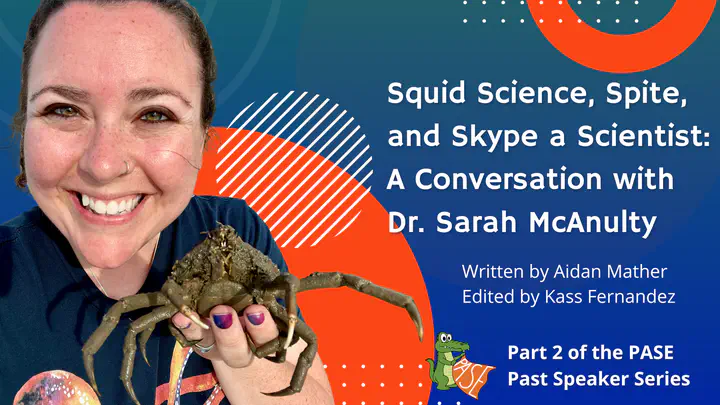 Graphic created by Kass Fernandez. Headshot (with spider crab) provided by Dr. Sarah McAnulty.
Graphic created by Kass Fernandez. Headshot (with spider crab) provided by Dr. Sarah McAnulty.When Dr. Sarah McAnulty was little, she already knew what she wanted to be: a squid scientist. Unlike most people, she actually followed her childhood dreams and built a career around her fascination, but her story doesn’t end with a lab bench or a research vessel. Instead, Dr. McAnulty’s trajectory brought her to the helm of a nonprofit that connects scientists and the public in thousands of classrooms and communities around the world.
Dr. McAnulty is the Executive Director of Skype a Scientist, the organization she founded as a PhD student at the University of Connecticut. Since 2017, the program has paired scientists with classrooms for virtual visits, creating direct connections between researchers and K-12 students who might otherwise never meet a scientist. What began as a side project quickly became a full-time career.
“My path is not remotely logical or straightforward,” she told me. “From when I was a little kid I wanted to be a squid scientist, so I pursued that career. I enjoyed both doing squid biology and talking about squid biology… but then 2017 happened.”
The political moment sharpened her sense that distrust in science was growing. “I realized that someone needed to do something about how horrible everything was.” Dr. McAnulty thought she could juggle both her passions: conducting squid research and building a program that connected scientists with the public. For a couple of years, she tried to straddle the two worlds, until reality caught up with her.
“I had to choose one or the other because there are only so many waking hours in a day. I assumed that the nonprofit would fail and I could go back to being a squid biologist as I had intended for the previous 22 years, but… it didn’t fail!”
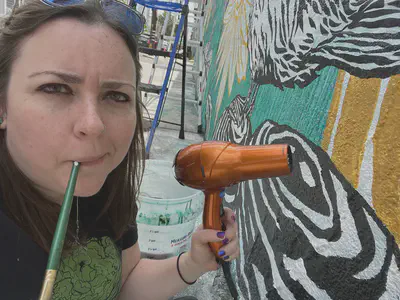
Building a Program That Stuck
When Skype a Scientist launched, the idea was simple: match scientists with classrooms through video calls. Over time, the program has grown well beyond its original scope.
“We’ve continued the program that I built and ran from the beginning,” Dr. McAnulty explained, “but we’ve expanded a lot into in-person community-based events and programming. The new programming includes everything from activities at block parties to community murals that focus on biodiversity, to creating and distributing science zines.”
This expansion reflects Dr. McAnulty’s deep-seated conviction that science belongs everywhere, not just in classrooms or lecture halls. She’s committed to reaching people who aren’t already “science-interested.”
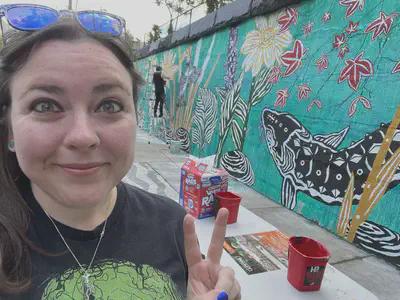
Squidmobiles, Murals, and the Power of Joy
That commitment shows up in some of her most playful projects: the Squidmobile (a car covered in squid-focused drawings, facts, and more), biodiversity murals, and even a squid facts hotline.
“It’s really important to me that my work reaches people who are not already in the science-interested crowd. I think that art-forward, really silly approaches are pretty good at reaching a portion of that crowd. I try to give people something that gives them just a little something for a hook, but has them thinking “What the f— is this about?” so that they want to engage further.”
Equally important, Dr. McAnulty emphasizes, is the tone of those interactions. Science should invite curiosity, not judgment.
“It’s really important to me that no one ever feel judged when interacting with my science communication, and that joy and curiosity drive the interaction.”
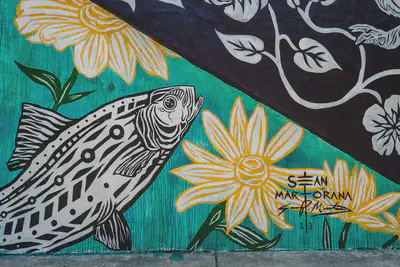
Challenges Along the Way
Starting a nonprofit as a graduate student wasn’t easy. There were skeptics who wondered why she was dedicating so much energy to outreach instead of her research, and there were long nights balancing both, but Dr. McAnulty says the real challenge is a familiar one to anyone in the nonprofit world: fundraising.
“Fundraising is always the hardest part, but that’s not a new or interesting answer,” she said matter-of-factly.
What kept her going was an ability to tune out unhelpful advice and focus on her vision.
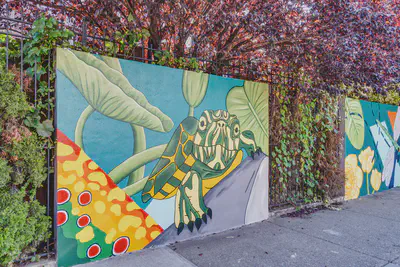
Lessons for Students
For students who might want to launch their own outreach efforts, Dr. McAnulty’s advice is grounded in humility and listening. “The one mistake to avoid is trying to build something before you’ve listened to the needs of the people you’re trying to serve. Listening is the most important skill in science communication. You need to understand your audience pretty well to effectively connect them with information in a way that they’re going to want to connect to.”
She also encourages students to check what already exists before reinventing the wheel, and to pay attention to where programming is most needed.
“It’s a real bummer when you put all this effort into building something only to realize that someone else is already doing it and you could have joined forces to make something stronger. For smaller initiatives in places where there isn’t a lot of programming happening, you might take a look around and realize you’re really needed there, but it’s always good to check first!”
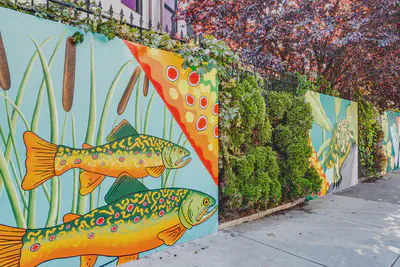
Fun, Spite, and Building Trust
When asked how creativity can build trust in science, Dr. McAnulty’s answer is as candid as it is memorable.
“Have fun first. People can tell when we’re doing things out of obligation instead of doing it from a place of joy. The actions of evil people may have motivated your art, but create something you enjoy creating, even if it’s fueled by rage, or spite. Spite can be really fun.”
It’s this mix of joy, defiance, and squid-shaped creativity that has carried Skype a Scientist from a side project to a thriving nonprofit. Dr. McAnulty may not have followed the straightforward path she imagined as a child, but the one she built instead continues to connect scientists with communities, one classroom, mural, and squid fact at a time.
Editor’s Note: You can keep up with Dr. McAnulty and Skype a Scientist on BlueSky!